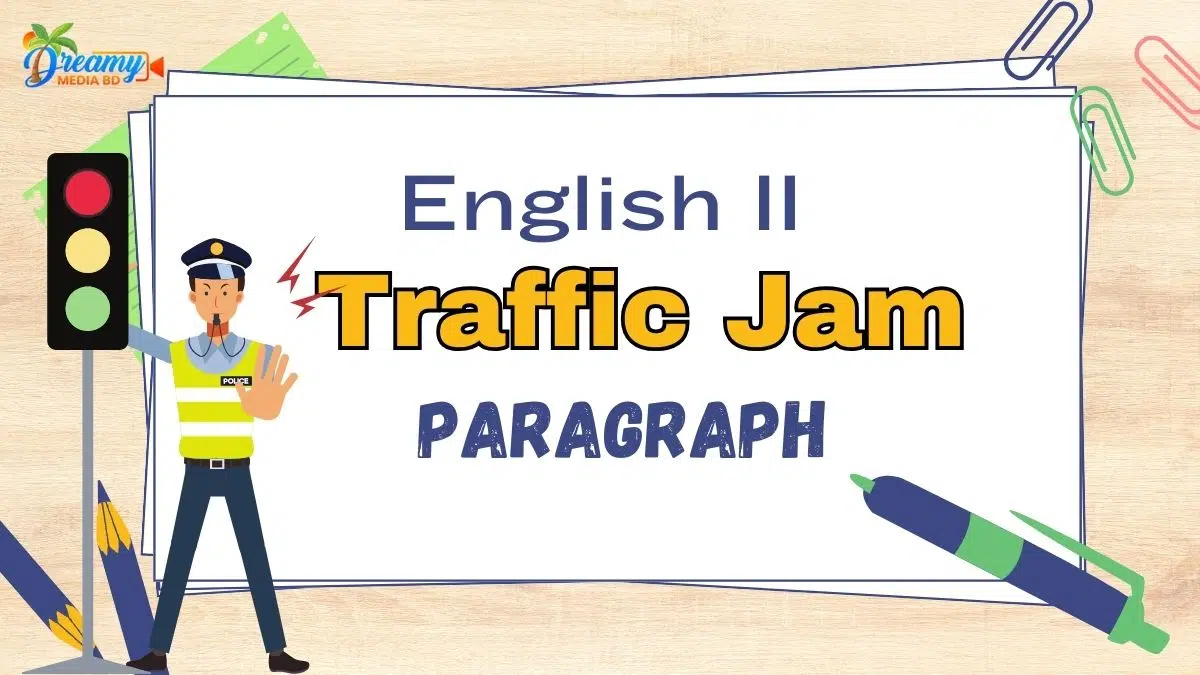Traffic jam Paragraph for all students
Traffic jam Paragraph is very important for every student in classes 3 to 12. In this post, we should try to cover the Traffic jam Paragraph for all students, like the Traffic jam Paragraph for Class 3 to 7 , Traffic jam Paragraph For JSC, Traffic jam Paragraph For SSC, Traffic jam Paragraph For HSC, and Traffic jam Paragraph any competition exam .
The importance of traffic jam paragraph
Traffic jams are a common occurrence in cities and highly populated areas. It refers to the situation where vehicles are at a standstill or moving very slowly due to excessive congestion on the roads. Traffic jams not only cause inconvenience to commuters but also have adverse effects on the environment and economy.
Traffic jam Paragraph 100 words for Class 3 to 7
Many cities across the world suffer from the annoying reality of traffic jams. People who commute experience delays and stress due to these congested situations, which arise when traffic stops moving. A spike in the number of cars on the road, poor road infrastructure, and dense population are some of the factors that can lead to traffic jams. A few more factors that exacerbate the issue are road construction, accidents, and a disregard for traffic laws. Traffic bottlenecks harm the environment, the economy, and people’s quality of life, in addition to wasting time. The ultimate goal of efforts to reduce traffic is to provide everyone with smoother, more sustainable mobility. These efforts include efficient public transportation systems, better urban planning, and the promotion of alternative forms of transportation.

Traffic jam Paragraph of 200 words For Class 8
Traffic jams are a widespread and frustrating phenomenon in urban areas worldwide. These congested situations occur when the flow of vehicles on the roads reaches a point of gridlock, resulting in significant delays, stress, and negative impacts on various aspects of daily life. There are multiple factors contributing to traffic jams. The rapid growth of urban populations leads to increased vehicle ownership, putting a strain on existing road infrastructure. More adequate road capacity is needed to accommodate the growing number of cars, causing bottlenecks and congestion. Additionally, road construction, accidents, and poorly coordinated traffic management further exacerbate the problem.
The consequences of traffic jams are far-reaching. They waste valuable time and productivity, as commuters spend excessive hours stuck in traffic instead of being engaged in more meaningful activities. Traffic congestion also has adverse effects on the environment, contributing to increased fuel consumption, air pollution, and greenhouse gas emissions. Furthermore, traffic jams have economic implications, with businesses facing losses due to delayed deliveries, reduced efficiency, and increased transportation costs.
Cities need to take a few steps to address traffic jams. To accommodate more cars, they can construct new roads or upgrade the ones that already exist. In addition, they can persuade people to forgo owning a car in favor of taking public transportation, such as buses and trains. To lower accident rates and maintain smooth traffic flow, they can also implement improved traffic management.

Traffic jam Paragraph 300 words For Class 10 or SSC Exam
Traffic jams are a big problem in many cities. They happen when there are too many cars on the road, and they can make people feel frustrated and stressed. There are a few reasons why traffic jams occur. One reason is that there are more cars than the roads can handle. Sometimes, the streets need to be built better, and they can’t drive the increased traffic. Accidents and road construction can also cause traffic jams. Traffic jams have adverse effects on our lives. They waste our time because we get stuck in traffic instead of doing things we need to do. They also harm the environment because cars produce more pollution when they are stuck in traffic. Traffic jams can also hurt businesses because deliveries are delayed, making it challenging for customers to reach stores.
Cities need to do a few things to solve traffic jams. They can build more roads or improve existing ones to handle more cars. They can also encourage people to use public transportation, like buses and trains, instead of driving their vehicles. Some cities have carpool lanes to encourage people to share rides. They can also have better traffic management to reduce accidents and keep traffic flowing smoothly.
Another critical factor is to improve the road infrastructure. Road capacity can be raised, and congestion can be reduced by building new roads, widening existing ones, and adding more lanes. By utilizing technologies like real-time traffic information and traffic light synchronization, intelligent transportation systems can help manage traffic more effectively.
Additionally, implementing telecommuting or flexible work schedules can aid in lowering peak-hour traffic. To prevent busy times, employers can encourage staff to work from home or space out their work schedules.
By taking these steps, cities can reduce traffic congestion and make life better for everyone. It will save time, reduce pollution, and make it easier for people to get where they need to go.

Traffic jam Paragraph 400 words For HSC Exam
Traffic jams are a common and frustrating problem in cities around the world. They occur when too many vehicles are on the road and traffic flow becomes slow or stagnant. Several factors contribute to traffic congestion. One major cause is the increasing number of cars on the road. As urban populations grow and people become wealthier, more individuals are able to afford cars. However, the road infrastructure often needs to catch up with this rapid increase in vehicle ownership. The result is a mismatch between the number of cars and the capacity of the roads, leading to congestion.
The consequences of traffic jams are numerous and impactful. Firstly, they waste valuable time for commuters. People spend hours stuck in traffic, leading to increased stress levels and decreased productivity. Secondly, traffic congestion has adverse environmental effects. Cars stuck in traffic consume more fuel and emit higher levels of pollutants, contributing to air pollution and greenhouse gas emissions.
Furthermore, traffic jams have economic implications. Businesses need more timely deliveries, increased transportation costs, and reduced efficiency. The overall economy can also be affected as productivity could be improved by the time wasted in traffic.
Cities can implement various strategies to address traffic jams. Firstly, investing in effective public transportation systems can reduce the number of cars on the road. Reliable and well-connected bus and train networks can encourage people to use public transport instead of driving. Carpooling initiatives and promoting cycling and walking as alternative modes of transportation can also alleviate congestion.
Improving road infrastructure is another crucial aspect. Constructing new roads, widening existing ones, and creating additional lanes can increase road capacity and mitigate congestion. Implementing intelligent transportation systems can assist in managing traffic more efficiently by using technologies such as traffic light synchronization and real-time traffic information.
Furthermore, adopting flexible work hours or telecommuting options can help reduce peak-hour traffic. Employers can encourage employees to work from home or stagger their work schedules to avoid congested periods. Those who would otherwise choose to drive their cars may be persuaded to switch to more reliable and well-connected public transport systems. There are other ways to lessen the number of vehicles on the road during peak travel times, such as carpooling, telecommuting, and flexible work schedules.
In conclusion, traffic jams are a significant issue that affects cities and their residents in various ways. By implementing a combination of measures such as investing in public transportation, improving road infrastructure, optimizing traffic management, and promoting alternative modes of transport, cities can work towards alleviating traffic jams and creating more livable and sustainable urban environments.

Traffic jam Paragraph 500 words for any competition exam
Traffic jams are a common sight in busy cities and urban areas. It is a phenomenon where vehicles become gridlocked and unable to move due to the high volume of traffic on the roads. This can be caused by a variety of factors, including accidents, road construction, rush hour traffic, or even just too many cars trying to use the same roads at once. One major cause of traffic jams is accidents. With more and more vehicles on the street, the chances of accidents increase. Even a minor fender bender can cause significant delays as it blocks one or more lanes, forcing other vehicles to maneuver around it and causing a ripple effect of slowdowns. Accidents also lead to rubbernecking and curious drivers slowing down to see what happened, further contributing to the traffic jam.
Another major cause of traffic jams is road construction. While it may seem counterintuitive, road construction can actually lead to more congestion on the roads. Detours and lane closures can divert traffic onto already busy roads, causing backups and delays. Additionally, construction vehicles and equipment often take up space on the road, reducing available lanes for other cars to use. One of the biggest culprits of traffic jams is rush hour traffic. As people commute to and from work at similar times, the roads become overwhelmed with cars, buses, and other vehicles. This leads to a high volume of traffic on the roads, causing backups and delays as everyone tries to get to their destination.
Another factor that contributes to traffic jams is too many cars on the road. With the rise of urbanization and economic growth, more and more people are buying cars, leading to a higher number of vehicles on the streets. This increases competition for limited road space, causing congestion and slowdowns. While traffic jams may seem like just an inconvenience, they have severe consequences beyond making people late for work or appointments. The increased idling time of cars stuck in traffic leads to higher levels of air pollution, contributing to environmental degradation. Additionally, the economic costs of traffic jams are significant, with studies estimating that billions of dollars are lost every year due to wasted fuel and productivity.
To combat this issue, cities and governments have implemented various strategies such as carpool lanes, public transportation initiatives, and congestion pricing to reduce the number of vehicles on the road. These efforts aim to alleviate traffic congestion and promote more sustainable modes of transportation.
Technology has also played a role in addressing traffic jams. Bright traffic lights that adjust their timing based on current traffic conditions have been shown to reduce congestion and improve traffic flow.
In conclusion, traffic jams are a common occurrence in busy cities and urban areas. They can be caused by accidents, road construction, rush hour traffic, and simply too many cars on the roads. However, with the implementation of various strategies and the use of technology, efforts are being made to alleviate this issue and promote more efficient and sustainable forms of transportation. As our world continues to grow and urbanize, we must find ways to minimize traffic jams for the benefit of both individuals and society as a whole. So, we must follow the rules while we are driving on the road that will decrease the chances of having traffic jams or accidents.

Frequently Asked Questions (FAQs)
Here are some common questions about traffic jams:
Q: What is considered a rush hour?
A: Rush hour refers to the peak time for traffic congestion during the morning and evening when people are commuting to and from work. Typically, rush hour can last for several hours in the morning and afternoon.
Q: How long does a typical traffic jam last?
A: The duration of a traffic jam can vary depending on the cause and location. It could range from a few minutes to several hours. In some extreme cases, traffic jams can even last for days.
Q: How does a traffic jam affect the economy?
A: Traffic jams can have a significant impact on the economy. It causes delays in the delivery of goods and services, resulting in lost productivity and increased cost of transportation. It also affects businesses located in areas with high traffic congestion, as it can deter customers from visiting their stores.
Also Read: A book fair Paragraph













